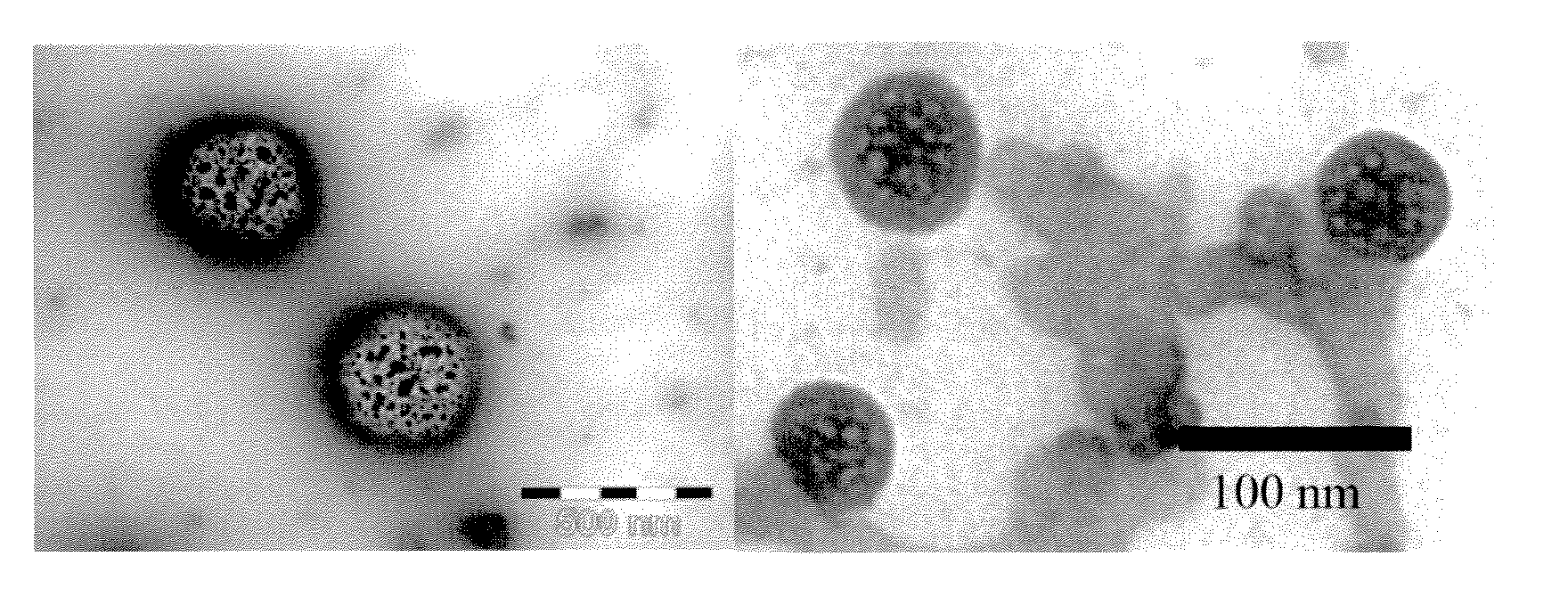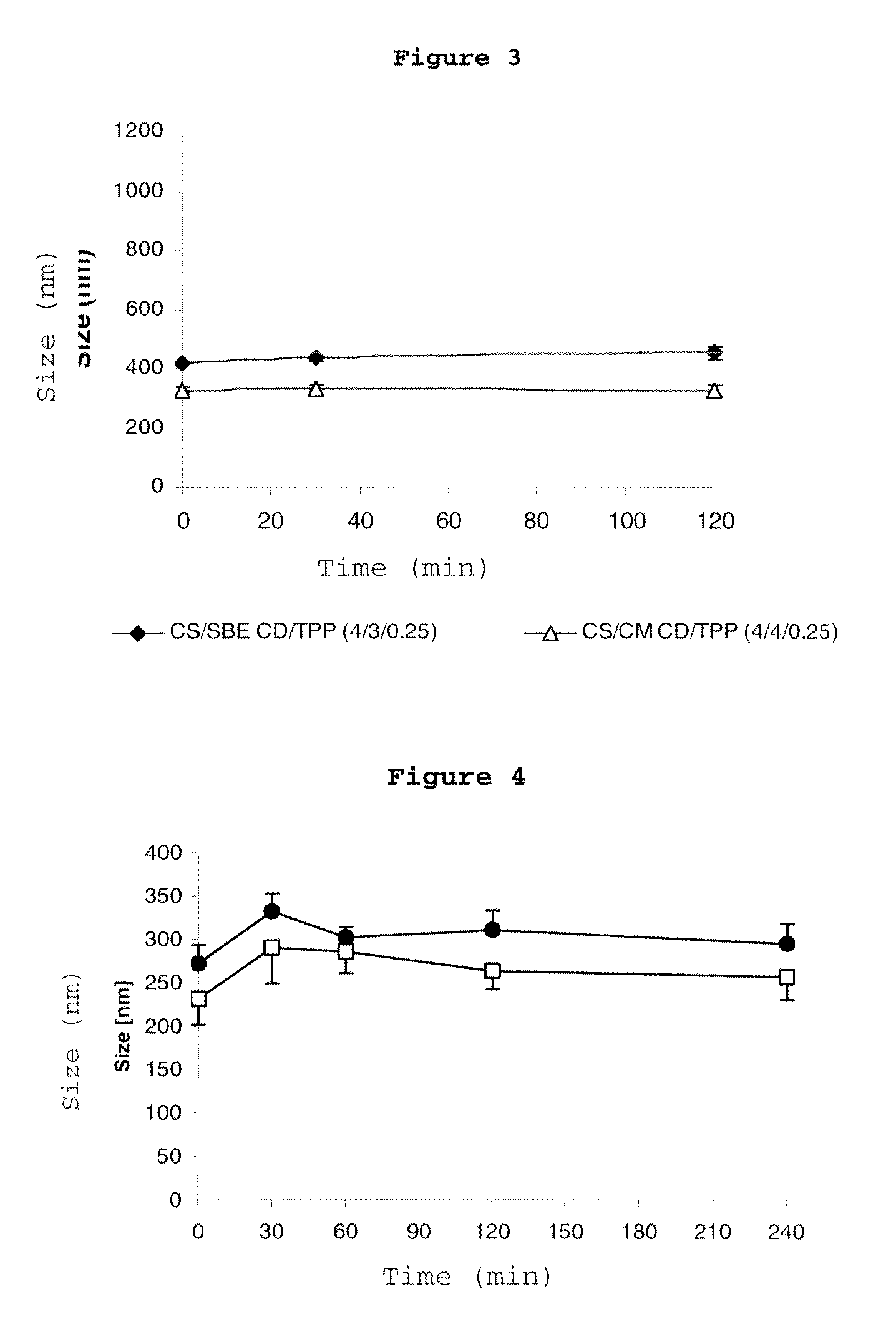Nanoparticles Comprising Chitosan and Cyclodextrin
a technology of nanoparticles and cyclodextrin, which is applied in the field of nanoparticle systems, can solve the problems of not being able to produce particles smaller than several micrometres, poor encapsulation efficiency of certain drugs, and present limitations of hydrophobic drug association, etc., to achieve better protection of the associated biologically active molecule, improve the ability to encapsulate, and improve the effect of encapsulation
- Summary
- Abstract
- Description
- Claims
- Application Information
AI Technical Summary
Benefits of technology
Problems solved by technology
Method used
Image
Examples
example 1
Evaluation of the Characteristics of Nanoparticles of Chitosan-Cyclodextrin as a Function of the Type of Chitosan and the Concentration of TTP
[0092]Fixed-concentration (6.29 mM) solutions (3 ml) of hydroxypropyl-.-cyclodextrin (HP.CD) were prepared with different chitosans (CS) (0.2% w / w). These solutions were incubated for 24 h under magnetic stirring and, subsequently, were filtered with a 0.45-.m filter and crosslinked by the addition of different volumes of tripolyphosphate at concentrations of 1.25 mg / ml or 2 mg / ml, such that a chitosan / tripolyphosphate mass ratio of 4:1 was always maintained. The nanoparticles were isolated by centrifugation at 16000×g and resuspended in water. The size of the nanoparticles was determined by means of photon correlation spectroscopy (PCS). The results related to the mean size and the polydispersion index of the nanoparticles as a function of the molecular weight of the chitosan used and of the concentration of the tripolyphosphate used as a cro...
example 2
Evaluation of the Characteristics of Nanoparticles of Chitosan-Cyclodextrin as a Function of the Type and the Concentration of Cyclodextrin (Concentration of TTP=2 mg / ml)
[0093]0.2% (w / w) solutions (3 ml) of chitosan, specifically chitosan hydrochloride (Protasan Cl110), were prepared with different quantities of hydroxypropyl cyclodextrin (.- or .-) (0 to 25 mM). The solutions were incubated for 24 h under magnetic stirring and, subsequently, were filtered through a 0.45-.m pore size and crosslinked by the addition of 0.75 ml of tripolyphosphate at concentrations of 2 mg / ml. The nanoparticles were isolated by centrifugation at 16000×g and resuspended in water. The size of the resulting particles and the polydispersion thereof were characterised by means of photon correlation spectroscopy (PCS), the zeta potential by means of laser-Doppler anemometry and the production yield by weighing the dry residue of a sample of isolated nanoparticles. The results are shown in table 2.
[0094]FIG....
example 3
Evaluation of the Characteristics of Nanoparticles of Chitosan-Cyclodextrin as a Function of the Type and the Concentration of Cyclodextrin (Concentration of TPP=1.25 mg / ml)
[0095]0.2% (w / w) solutions (3 ml) of chitosan (Protasan Cl110) were prepared with different quantities of hydroxypropyl cyclodextrin (.- or .-) (0 to 25 mM). The solutions were incubated for 24 h under magnetic stirring and, subsequently, the solutions were filtered through a 0.45-.m pore size and crosslinked by the addition of 1.2 ml of tripolyphosphate at concentrations of 1.25 mg / ml. The nanoparticles were isolated by centrifugation at 16000×g and resuspended in water. The size of the resulting particles and the polydispersion thereof were characterised by means of photon correlation spectroscopy (PCS), the zeta potential by means of laser-Doppler anemometry and the production yield by weighing the dry residue of a sample of isolated nanoparticles. The results are shown in table 3.
[0096]FIG. 1 (right-hand-side...
PUM
| Property | Measurement | Unit |
|---|---|---|
| molecular weight | aaaaa | aaaaa |
| molecular weight | aaaaa | aaaaa |
| size | aaaaa | aaaaa |
Abstract
Description
Claims
Application Information
 Login to View More
Login to View More - R&D
- Intellectual Property
- Life Sciences
- Materials
- Tech Scout
- Unparalleled Data Quality
- Higher Quality Content
- 60% Fewer Hallucinations
Browse by: Latest US Patents, China's latest patents, Technical Efficacy Thesaurus, Application Domain, Technology Topic, Popular Technical Reports.
© 2025 PatSnap. All rights reserved.Legal|Privacy policy|Modern Slavery Act Transparency Statement|Sitemap|About US| Contact US: help@patsnap.com



